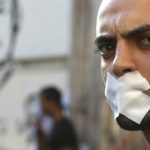By Youssef Sidhom – Watani –
Since 1971..the Church has repeatedly applied for licence to build a new church but was never granted one; no reason was ever given by the authorities.
When the Law for Building and Restoring Churches was passed in September 2016, it aroused heated controversy. Some Egyptians were elated that the long-awaited legislation had finally seen light and were optimistic about it. Others were sceptical and read between its lines an absence of political and executive will to empower citizenship rights for all Egyptians regardless of what religion they belonged to. I was optimistic and called for giving the law a chance.
I said that Copts must put their worries aside and get to work on testing the new law. They should apply for permits to build the churches needed and to restore the ones that required restoration, also to legalise the status of churches that had been built without licence before the law was passed. I wrote that the law should be put to the test through its on-the-ground application. Depending on how it is applied, the law has the potential of either easing or complicating everything related to church building and restoration. Watani, I wrote, would objectively shed light on how the law is applied, citing the cases in which church-building was accordingly facilitated or complicated. Given that the law places the decision on church-building matters in the hands of the governors, and given our long experience with governors who diverge widely in the will to grant Copts their rights, we said we would closely monitor the application of the new law.
Last October, nearly a month after the law was passed, I wrote of a decision by Housing Minister Mustafa Madbouli that approved the allocation of land for building three new churches in Badr City, New Minya, and New Fayoum.
I applauded these approvals but was cautiously optimistic, since the real test lay in the following phase of construction. I wrote that Coptic collective consciousness overflowed with bitter memories of abrupt interruption of officially licensed works of church building or restoration because some fanatic [Muslim] individual or group attacked the site. The local security officials more often than not looked on then ordered an indefinite stoppage of the work ‘for security reasons’.
Today I present the case of the church of the Holy Virgin in the hamlet of Naja Rizq Shenouda, Tahta, Sohag, some 450km south of Cairo. Girgis Zakariya Zaky, appointed legal representative of the Church by Anba Asheiya, Bishop of Tahta, sent me a letter citing the problems they are facing to get a permit to build a church.
“The Copts of Naja Rizq Shenouda have suffered since 1971 on account of the refusal of the local authorities to grant them a permit to build a church on a 618sq.m-plot of land owned by the Church and officially registered as Church property. There is no church in the hamlet which is home to some 3500 Copts; the Copts worship in a rundown building—if it can be termed ‘building’—that has no ceiling and thus no privacy and is moreover unshielded against weather conditions.” Since 1971, Mr Zaky wrote, the Church has repeatedly applied for licence to build a new church but was never granted one; no reason was ever given by the authorities.
After the Law 80 for 2016 was passed, which governs the building and restoration of churches, the Church on 29 December 2016 submitted an application to Sohag Governor for licence to build a new church on its land. All the documents required were attached to the application which was handed to the governor’s office and given serial number (2). A document signed by 750 Naja Rizq Shenouda Copts stressing their urgent need for a church was attached to the application.
On 22 January 2017, Sohag Governor Ayman Abdel-Moniem referred the application to Sohag Security. This procedure lacks legal justification, and violates the Law for Building Churches Article (3) which stipulates that “the legal representative of the congregation applies to the relevant governor for the permits legally needed for any of the works requiring licence. The executive authority must give the applicant proof of receiving his application on the same date he applies”. This means that the governor is the one legally responsible for issuing building permits. But Sohag Governor referred the matter to the security authority, which constituted an infringement against the law. It furthermore brought back to life half-a-century-long Coptic suspicions of the arrogant security authorities’ oppression that impeded the building of their church. So despite optimism that the new law would be the first Egyptian legislation to free churches from the security grip, here comes the church of Naja Rizq Shenouda in Sohag to take us back again.
I will not lose faith in the Law for Building and Restoring Churches, but I still insist that the law stands the test of time. This can only be done through monitoring how it is applied. In Sohag, it complicated the building of a church. We should stand up to this in order to defend both the law and citizenship rights.
____________________





